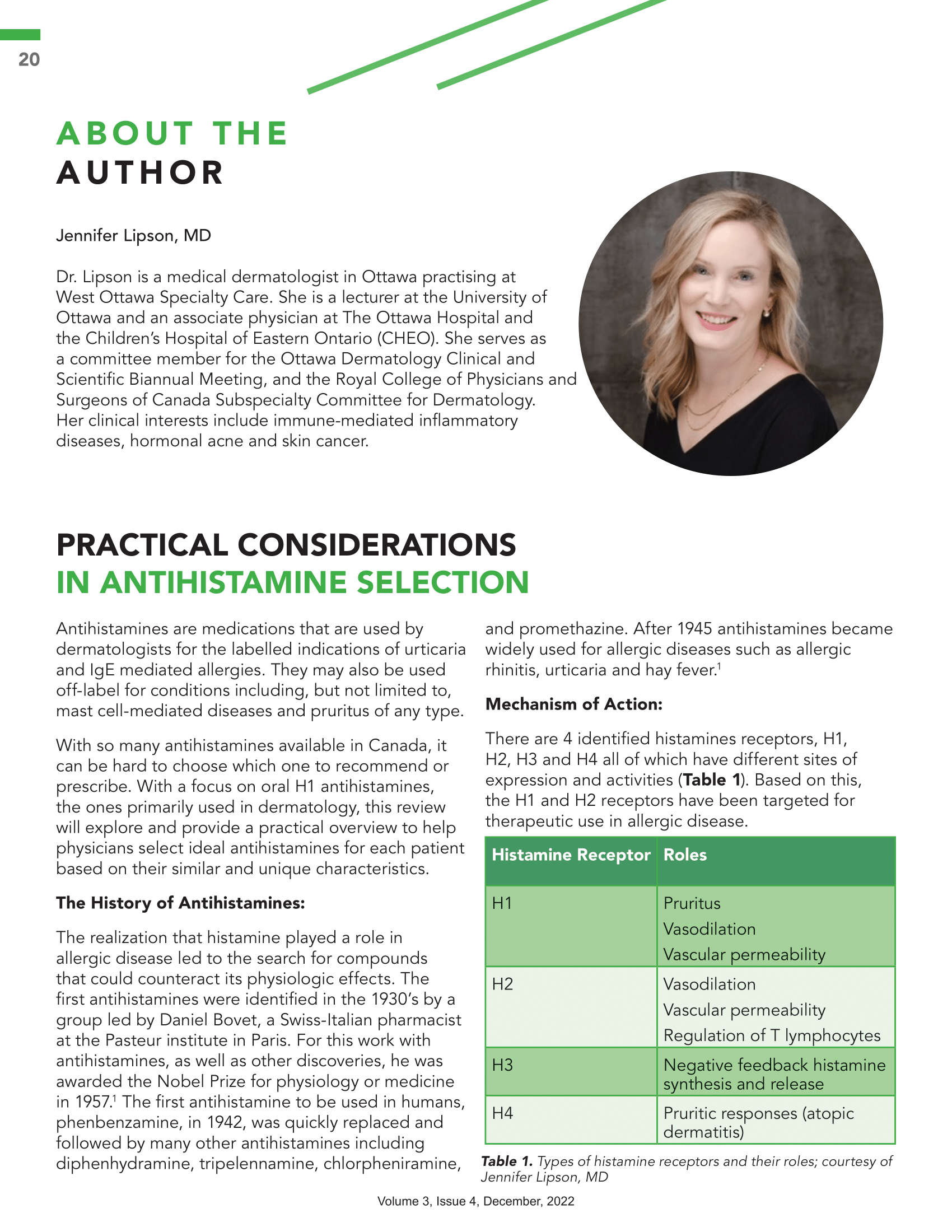Practical considerations In antihistamine selection
Abstract
Antihistamines are medications that are used by dermatologists for the labelled indications of urticaria and IgE mediated allergies. They may also be used off-label for conditions including, but not limited to, mast cell-mediated diseases and pruritus of any type.
With so many antihistamines available in Canada, it can be hard to choose which one to recommend or prescribe. With a focus on oral H1 antihistamines, the ones primarily used in dermatology, this review will explore and provide a practical overview to help physicians select ideal antihistamines for each patient based on their similar and unique characteristics.
References
Parsons, Mike E., and C. Robin Ganellin. “Histamine and its receptors.” British journal of pharmacology 147.S1 (2006): S127-S135.
Wolverton, Stephen E., and Jashin J. Wu. Comprehensive dermatologic drug therapy. Elsevier Health Sciences, 2019.
Gray, Shelly L., et al. “Cumulative use of strong anticholinergics and incident dementia: a prospective cohort study.” JAMA internal medicine 175.3 (2015): 401-407.
Risk of first-generation H(1)-antihistamines: a GA(2)LEN position paper. Church MK, Maurer M, Simons FE, Bindslev-Jensen C, van Cauwenberge P, Bousquet J, Holgate ST, Zuberbier T, Global Allergy and Asthma European Network Allergy. 2010;65(4):459. Epub 2010 Feb 8.
Antihistamines and driving ability: evidence from on-the-road driving studies during normal traffic. Verster JC, Volkerts ER Sann Allergy Asthma Immunol. 2004;92(3):294.
Busse, Paula J. “Allergic respiratory disease in the elderly.” The American journal of medicine 120.6 (2007): 498-502.
Cumulative use of strong anticholinergics and incident dementia: a prospective cohort study. Gray SL1, Anderson ML2, Dublin S3, Hanlon JT4, Hubbard R5, Walker R2, Yu O2, Crane PK6, Larson EB7.JAMA Intern Med. 2015 Mar;175(3):401-7
A comparison of the United States and International perspective on chronic urticaria guidelines. T. Zuberbier, J. Bernstein . 2018, The journal of allergy and clinical immunology. 6:1144
Cataldi, Mauro, et al. “Cardiac safety of second-generation H1-antihistamines when updosed in chronic spontaneous urticaria.” Clinical & Experimental Allergy 49.12 (2019): 1615-1623.
Sharma M1, Bennett C, Cohen SN, Carter B. H1-antihistamines for chronic spontaneous urticaria. Cochrane Database Syst Rev. 2014 Nov 14;(11)
Bogacka, E. et al. Comparison of the efficacy and safety of bilastine 20 mg vs. lecocetirizine 5 mg for the treatment of chronic idiopathic urticaria, a multicentre , double blinded, randomized placebo controlled study. Allergy 2010:;65(4):516-28
Bilastine a New Nonsedating Oral H1 Antihistamine for treatment of Allergic Rhinoconjunctivitis and Urticaria. Wolthers, O. Biomed Research Internernational 2013.
Dakhale, Ganesh N., et al. “Clinical effectiveness and safety of cetirizine versus rupatadine in chronic spontaneous urticaria: a randomized, double-blind, 6-week trial.” International journal of dermatology 53.5 (2014): 643-649.
Potter P. et al. Rupatadine is effective in the treatment of chronic spontaneous urticaria in children aged 2-11 years. Pediatr Allergy Immunol 2016:27:55-61.
Church, Martin K. “Comparative inhibition by bilastine and cetirizine of histamine-induced wheal and flare responses in humans.” Inflammation Research 60.12 (2011): 1107-1112.
Antonijoan, Rosa, et al. “Comparative efficacy of bilastine, desloratadine and rupatadine in the suppression of wheal and flare response induced by intradermal histamine in healthy volunteers.” Current Medical Research and Opinion 33.1 (2017): 129-136.
Certirizine PM; https://pdf.hres.ca/dpd_pm/00046970.PDF
Tyl, Benoît, et al. “Lack of significant effect of bilastine administered at therapeutic and supratherapeutic doses and concomitantly with ketoconazole on ventricular repolarization: results of a thorough QT study (TQTS) with QT-concentration analysis.” The Journal of Clinical Pharmacology 52.6 (2012): 893-903.
Krause, K., et al. “Up-dosing with bilastine results in improved effectiveness in cold contact urticaria.” Allergy 68.7 (2013): 921-928.
Karasawa K. Clinical aspects of plasma platelet-activating factor-acetylhydrolase. Biochim Biophys Acta. 2006;1761:1359–72.
Vadas, Peter, et al. “Platelet-activating factor, PAF acetylhydrolase, and severe anaphylaxis.” New England Journal of Medicine 358.1 (2008): 28-35.
Miwa, M., et al. “Characterization of serum platelet-activating factor (PAF) acetylhydrolase. Correlation between deficiency of serum PAF acetylhydrolase and respiratory symptoms in asthmatic children.” The Journal of clinical investigation 82.6 (1988): 1983-1991.
Rupatadine PM, 2022; pdf.hres.ca/dpd_pm/00056493.PDF
Torsade de pointes associated with rupatadine. Fité-Mora R.Rev Esp Cardiol. 2009 Mar;62(3):330-1; author reply 332. Doi: 10.1016/s1885-5857(09)71568-3.PMID: 1926808
Torsades de pointes associated with rupatadine].Nombela-Franco L, Ruiz-Antoran B, Toquero-Ramos J, Silva-Melchor L.Rev Esp Cardiol. 2008 Mar;61(3):328-9.PMID: 18361911
Miranda So, Pina Bozzo, Miho Inoue and Adrienne Einarson; Safety of antihistamines during pregnancy and lactation. Canadian Family Physician May 2010, 56 (5) 427-429.


